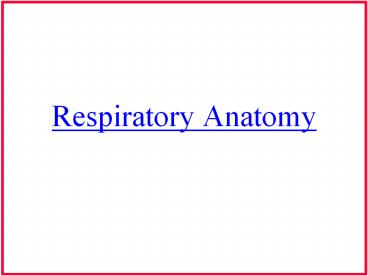Respiratory Anatomy - PowerPoint PPT Presentation
1 / 18
Title: Respiratory Anatomy
1
Respiratory Anatomy
2
Muscles of Expiration
- Unlike inspiration expiration is an interaction
between passive active forces - active rib cage and abdominal muscles
(opposition to diaphragm) - passive recoil forces, gravity
- 3 relatively independent forces
- Passive forces
- Active diaphragm-abdomen forces
- Active rib cage forces
3
Internal Intercostals
- Fill spaces between ribs (except in back) on the
inside of the chest - Connect ribs at opposite angles to external
intercostals - Work in opposition to each other
(external/internal) - Internal pull down from the pelvis through
connection with abdominal muscles - External Pull upward from the spine, skull, neck
and fixate upper ribs
4
Transversus Thoracis
- Upward outward from lower sternum to insert
into 2nd-6th ribs - Flat muscle lying along inside front wall of the
chest - Upper fibers run obliquely assist in pulling
the chest downward
5
Subcostal Muscles
- Along lower inside back wall of the thorax
- Originate from lower ribs near the vertebral
attachment - Run outward and up to insert into ribs one or
more higher - Pull lower ribs (bucket handle) inward downward
6
Internal Rib Cage Muscles of Exhalation
Transversus Thoracis
Outside view of back wall of lower six ribs
Inside view of front wall of upper six ribs
Internal Intercostals
Subcostals
7
Serratus Posterior Inferior
- Slants upward outward from lower thoracic and
upper lumbar vertebrae - Inserts into the lowest four ribs
- Size, angle of pull leverage to depress the
lower ribs with strong force
8
Quadratus Lumborum
- Strongly pulls down on the lowest floating rib
- Pulls from its attachment along the upper border
of the hip (coxal bone) - Flat vertical muscle in the posterior abdominal
wall
9
External Rib Cage Muscles of Exhalation
Serratus Posterior Inferior
Quadratus Lumborum
10
Abdominal Muscles of Expiration
- Abdominal wall muscles provide major active force
in exhalation - Contribution to breathing is compression of
viscera that push up on diaphragm - Pushing displaces 60-80 of the exhaled volume
- Function as rib cage depressors (pull down on
thorax) abdominal compressors
11
Rectus Abdominus
- Large, vertical ribbon muscle
- Runs from front of pelvis along midline of belly
to the sternum lower ribs - Limited in amount of compression it applies
(Pulls in a straight line) - Downward pull on sternum provides powerful
exhalatory force
12
External Oblique
- Originates from the lower 8 ribs and sweeps down
and forward - Posterior fibers descend vertically to crest of
coxal bone - Other fibers slant obliquely forward toward
midline - Insert into tendinous sheath called abdominal
aponeurosis (covers rectus abdominus) - Contribute to exhalation by pulling down on the
thorax while compressing viscera
13
Internal Obliques
- Thinner muscle, middle layer of abdominal wall
- Course of fibers opposite to external obliques
- Originate along upper border of coxal bone, fan
out and up - Fan out at right angles to the external obliques
- Insert at the midline into the abdominal
aponeurosis cartilages of the lower ribs - External Internal pull down on the thorax and
squeeze the viscera
14
Transversus Abdominus
- Deepest layer of abdominal muscle
- Horizontal fibers sweep from the vertebrae in the
back of the abdomen - Insert into abdominal aponeurosis
- Attaches above to the lower border of the ribs
(the cartilages of the lower 6 ribs) - Attaches below to the upper border of the pelvis
(coxal bone)- Like a corset (compress viscera) - Corset action- Ext. Int. obliques add
- Paired muscle- Tug of war
15
Abdominal Muscles of Exhalation
Rectus Abdominus
Transverse Abdominus
Internal Oblique
External Oblique
16
Passive forces
- Inspiration- raises rib cage against gravity
- cartilage are twisted
- viscera compressed
- alveolar sacs inflated against surface tension
- greater the inhalation greater resistance
(muscles) - Muscles relax passive forces
- Untorquing
- Gravity
- Elastic recoil of lungs
17
Relaxation Pressure
Ribs Raised
Exhaled
Torqued cartilage
Elastic Recoil
Inhaled
Gravity
18
Assignments
- Reading
- Seikel Ch.3 (Pgs. 99-109)
- Maue-Dickson Ch.3 (116-122)































